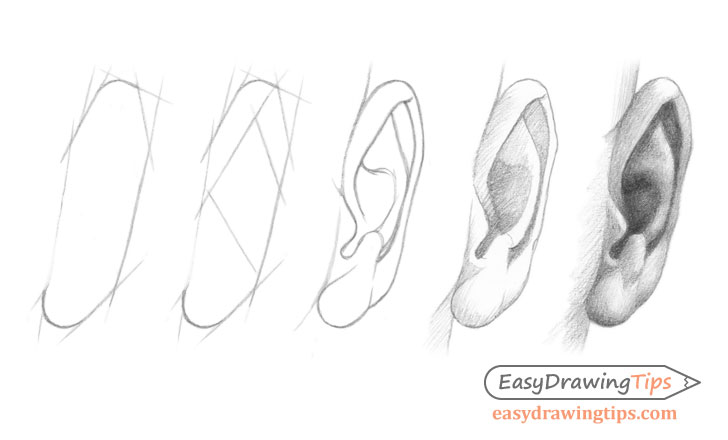Ear front draw ears rapidfireart drawing easy realistic learn steps thumbnail shade pencil
Table of Contents
Table of Contents
Are you struggling with drawing ears from the front? Do your portraits feel incomplete without properly drawn ears? Drawing ears from the front can be a daunting task, but with a little practice and guidance, anyone can master it.
Challenges of Drawing Ears from the Front
One of the biggest challenges of drawing ears from the front is getting the proportions right. Ears come in all shapes and sizes, but there are some general guidelines that can be followed to achieve a realistic look. Another challenge is capturing the subtle details that make each ear unique, such as the shape of the helix and tragus.
How to Draw Ears from the Front
To draw ears from the front, start by sketching the basic shape of the ear using simple shapes like circles and triangles. Next, add the details like the helix and tragus, and refine the shape until it looks realistic. Check your proportions by comparing the height of the ear to the width of the face. Use reference images and tutorials to get a better understanding of the unique features of each ear.
Summary of Main Points
To draw ears from the front, start with basic shapes, add details, and refine the shape until it looks realistic. Remember to check proportions and use reference images to capture the unique features of each ear.
Target: Understanding the Anatomy of Ears
Understanding the anatomy of ears is crucial to drawing them accurately. The ear is composed of three parts: the outer ear, middle ear, and inner ear. The outer ear is the visible part of the ear that includes the helix, the tragus, and the earlobe. The middle ear contains the eardrum and tiny bones that amplify sound. The inner ear contains the cochlea and is responsible for balance and hearing.
When drawing ears from the front, focus on the outer ear’s details, such as the helix and tragus. These shapes create the outline of the ear and can vary drastically in shape and size from person to person. To capture these details accurately, use reference images and practice sketching different ears.
Capturing the Unique Features of Ears
Ears, like people, are unique. Capturing the subtle details that make each ear unique can be challenging but rewarding. To practice capturing these details, focus on the shape of the concha, the curves of the helix, the angle of the tragus, and the shape of the earlobe. Study reference images and practice sketching different ears until you feel comfortable with the process.
Target: Using Light and Shadow to Create Depth
Light and shadow are crucial to creating a realistic-looking ear. Shadows give depth to the ear and create the appearance of curves and contours. To create realistic shadows, imagine the light source coming from one direction and shading the opposite side of the ear. Use a combination of light and heavy strokes with your pencil to achieve the desired effect.
Practicing Light and Shadow Techniques
One way to practice light and shadow techniques is to study reference images and try to replicate the shadows using pencil strokes. Experiment with different levels of pressure and varying stroke lengths to achieve different effects. With practice, you’ll be able to create realistic-looking ears that are full of depth and dimension.
Question and Answer
Q: What is the best way to practice drawing ears from the front?
A: The best way to practice drawing ears from the front is to use reference images and try sketching different ears. Pay attention to the unique features of each ear, like the shape of the helix and tragus, and use light and shadow to create depth.
Q: Should I use a reference image when drawing ears from the front?
A: Yes, using a reference image is highly recommended when drawing ears from the front. Reference images can provide insight into the unique features of each ear and help with proportion and accuracy.
Q: Why is light and shadow important when drawing ears from the front?
A: Light and shadow are crucial to creating a realistic-looking ear. Shadows give depth to the ear and create the appearance of curves and contours.
Q: What tools should I use when drawing ears from the front?
A: When drawing ears from the front, use a pencil and eraser to sketch out the basic shapes and details. Use a variety of strokes and levels of pressure to create depth and dimension.
Conclusion of How to Draw Ears from the Front
Drawing ears from the front can be challenging, but with practice and patience, anyone can master it. Remember to focus on the unique features of each ear, like the shape of the helix and tragus, and use light and shadow to create depth. With these tips, you’ll be drawing realistic-looking ears in no time.
Gallery
How To Draw An Ear From The Front In 11 Steps | RapidFireArt

Photo Credit by: bing.com / ear front draw ears rapidfireart drawing easy realistic learn steps thumbnail shade pencil
How To Draw Ears | How To Draw Ears, Art Tutorials Drawing, Art Journal

Photo Credit by: bing.com /
How To Draw The Ear From The Front, Step By Step Tutorial For Beginners

Photo Credit by: bing.com / draw ear front step ears drawing board tutorial choose
Ear Drawing Reference Front View - Robotse Wallpaper

Photo Credit by: bing.com /
How To Draw Ears

Photo Credit by: bing.com /





